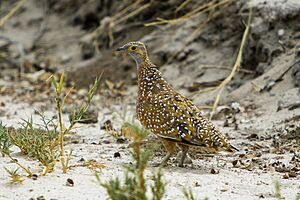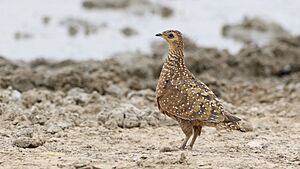Burchell's sandgrouse facts for kids
Quick facts for kids Burchell's sandgrouse |
|
|---|---|
 |
|
| male | |
 |
|
| female | |
| Conservation status | |
| Scientific classification | |
| Genus: |
Pterocles
|
| Species: |
burchelli
|
The Burchell's sandgrouse (Pterocles burchelli) is a special type of bird. It belongs to a family of birds called Pteroclidae. You can find these birds in dry and semi-dry areas of southern Africa. This bird was named after an English scientist, William John Burchell.
Contents
Meet the Burchell's Sandgrouse
The Burchell's sandgrouse is a plump bird. It is about the same size as a pigeon. It has a small head and short legs. Its body is light brown with darker spots and white flecks.
Male sandgrouse have yellow skin around their eyes. Their cheeks and throat are a pale grey color. Males grow to be about 25 centimeters (10 inches) long. Females are usually a little smaller.
How They Stay Cool
Living in the desert means it can get very hot. Burchell's sandgrouse have special ways to stay cool. When it gets too hot, they flutter their throats very fast. They also pant to cool down, just like a dog. This helps them survive temperatures up to 43.8°C (111°F).
Bringing Water to Chicks
One amazing thing about adult Burchell's sandgrouse is how they carry water. They bring water back to their chicks at the nest. First, they rub their bellies on dry ground. This ruffles up their belly feathers. Then, they wade into water and bob up and down. This helps their feathers soak up a lot of water.
Male sandgrouse can carry about 22 milliliters (0.74 fluid ounces) of water. Females can carry about 9 milliliters (0.3 fluid ounces). Once they have the water, they fly back to their nest. Their chicks then drink the water right from their parents' wet belly feathers!
Where They Live
Burchell's sandgrouse live in several countries in southern Africa. These include Angola, Namibia, Botswana, Zambia, Zimbabwe, and South Africa. They usually stay in one place. However, they might move a bit to find water and the seeds they eat.
These birds are common in many parts of their home range. They like areas with rough grass and bushes. They especially like places with red Kalahari sand. Farmers have dug more water holes, which has helped these birds spread to new areas.
Family Life
Burchell's sandgrouse usually have one mate for life. They lay their eggs during the dry season. This is between April and October.
Their nest is a small dip in the ground. It is often hidden among grass or under a bush. They line the nest with a few pieces of dry plants. Females usually lay two or three eggs.
Both parents take turns sitting on the eggs to keep them warm. When the chicks hatch, they are covered in soft down feathers. They can run around very soon after hatching. Both parents take care of the young birds. Just like with other sandgrouse, the parents bring water to their chicks. They carry it in their special breast feathers.


